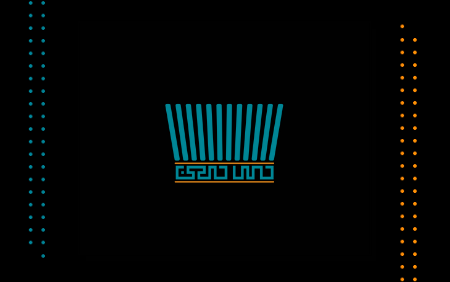"Cashmere" : Termeh
The cashmere fabric is a fine and delicate fabric that consists of two series of warp named warp and woof so that the woof placed on the back of the fabric and it is loose and densely packed. It is made up of wool or silk with Original and traditional designs of the Middle East. The beginning of cashmere weaving in Iran dates back to the early Safavid era, although some believe that the main source of cashmere is the centre of Central Asia and Kashmir highlands. Some people also believe that weaving of cashmere originated in Iran first and then went to Kashmir. What can be said about this very delicate fabric is that the sense and the innovation of Iranian in the subtlety of texture, material, and stunning designs are unmatched in the world. This art reached the peak of its flourishing and evolution during Shah Abbas Safavid era, which became famous in the world and became one of the Export products.
Cashmere weaving steps:
1.Raw materials: The first step of cashmere waving is the preparing of raw materials. Usually, cashmere is woven from wool and silk weave, but white wool is the most common wool used in cashmere wave because it can be used with any desired colour. The cashmere wool should be of high quality and have high fibre that the sheep of Iran and Kashmir have good, soft and firm wools and to a great extent, it is shiny and white. And the best sheep wool is in its flanks, abdomen, back of the neck a head and legs. And these wools are usually used for cashmere weaving. The preparation, spinning and dyeing and weaving of wool have progressed greatly in Iran during the 16th century. Due to the fact that Shah Abbas invited great designers from China and Armenia to Iran to teach their art to Iranians, the era of Shah Abbas Safavid can be celebrated during the peak of the cashmere weaving industry, that's why the cashmere had a special beauty and prominence at that time.
2.Wool washing: After the best quality wool is produced, the first step is to clean the wool from the available fat and dirt, which should be done before dying. Usually, the Iranians wash the animal for 10 minutes in the water before scouring the sheep. Then, to remove the fat from the wool, wet it in a base (alkaline) and then wash it several times with water, so that impurities are removed and the wool become shiny.
3.Whitening of wool: Two methods are used to whiten the wool in Iran.
First method: Spread the wool on the grass so that it was whitened after absorption of dew and evaporated on the day, and it was done in several steps.
Second method: Use of sulfur derivatives to whiten the wool.
1.Colour Stabilization: After the wool is white enough, it is time to paint them, which is one of the most important steps in making wool for cashmere waving. Because the colours used directly have not stability and persistence, and the Iranian dyer used "Dental" materials to solve this problem. Dental is a chemical that increases the ability to absorb the colour in the wool. To make dental a good reaction to dyeing, it should be purified beforehand. The most commonly used dental in Iran are a white alum, tin, zinc, lead and other sulfates which were minerals, Quercus infectoria, and sumac leaves, etc., that are plant materials.
2.Dyeing by natural and plant colours: Iranian cashmere paints are usually made from natural plants. This colour can be obtained from the roots, trunks, leaves, flowers, fruits or skin of plants. Because the maintenance of wool cashmere fabrics is very difficult and has been lost due to moisture and willow, little information is left of their colour.
Types of cashmere
The types of Iranian and Kashmiri cashmere are as follows:
1.Charghad Scarf: Its size is 1.5 * 1.5, and is used for scarves or boghche, which is commonly used as a triangular Toranj(lachak toranji) and floral type.
2.Striped shawl: It had 2 types:
- Striped wide shawl
- narrow striped shawl
Each of them has the type of consumption appropriate to the person's taste in their use.
1.Atabaki Shawl: It's a kind of Kashmiri and is woven from very delicate wool.
2.Bandi shawl: The map is like a nest of bees (Lane-Zanbouri) and there is a flower or a Botte inside each house.
3.Shawl of Muharramat: A kind of striped shawl is said to have different widths.
4.Kashmiri shawl: It is commonly referred to as Kashmir shawls, the most famous of which is Paisley (Bote-Jeghe) the Shakhe Gavazni map and treemap.
5.Emerald shawl: An elegant type of shawl is Kashmiri, which has an azure colour background with a Bote-Jeghe (Paisley) pattern and vivid colours, especially emerald green.
6.Kerman shawl: It's said to all the coof Kerman's texture and it has various kinds.
7.Amiri shawl: As its name suggests, it is kind of courtier and excellent Kashmir shawl types and commonly seen as the Bote-Joghe (Paisley) and antler (Shakh-Gavazn).
8.Yazdi shawl: Yazdi's cashmere is said to be part of the cashmere of the Yazd area, which is mostly either striped or Shah Abbasian flowers that are old and rare.
The use of cashmere in the past and present
Cashmere has had a variety of different uses in recent times, including sewing fine clothes, aristocratic clothes, curtains, prayer mats, khelati(robe of honour)and so on. Today, cashmere is used as a back fabric of furniture and backrest and tablecloth. Consumers of cashmere were more noblemen and kings in the past, and presently most middle and upper classes of the society use it as gifts for weddings, celebrations, official ceremonies and family celebrations.
The cashmere fabric is a fine and delicate fabric that consists of two series of warp named warp and woof so that the woof placed on the back of the fabric and it is loose and densely packed. It is made up of wool or silk with Original and traditional designs of Iran.
The beginning of cashmere weaving in Iran dates back to the early Safavid era, although some believe that the main source of cashmere is the centre of Central Asia and Kashmir highlands. Some people also believe that weaving of cashmere originated in Iran first and then went to Kashmir. What can be said about this very delicate fabric is that the sense and the innovation of Iranian in the subtlety of texture, material, and stunning designs are unmatched in the world. This art reached the peak of its flourishing and evolution during Shah Abbas Safavid era, which became famous in the world and became one of the Export products of Iranian.
Cashmere weave tools and methods
The cashmere Weaving machine is almost the same as wood and textile traditional machinery and is made in the local production area by local craftsmen. This type of device has four input, witch moving by the pedals under the weaver's foot. After preparing the raw materials and preparing the weaving machine, the binding warp (Cheleh-Keshi) process is performed in a form that is common in the other textiles and then the weave operation is begun. Each cashmere device needs a Gushvareh-kesh that the master artist is seated behind the device and the Gushvareh-kesh are placed on top of it and his work is to select and determine special threads to create a pattern on the fabric, and the motifs that are usually seen on Iranian cashmere are the result of the collaboration of the Gushvareh-kesh device with the master artist.
Existing evidence shows the fact that cashmere weave has been a very difficult task.
Cashmere weave with traditional devices requires a lot of time, accuracy and skill and with the help of this device, about 20 to 25 centimetres of good quality cashmere can be used throughout the day (equivalent to 8 hours of useful work), but a Jacquard machine actually handles Gushvare_kesh machines task and the production has increased slightly and reached about 100 centimetres a day. One of the most sensitive tasks of the weaver is to choose the colour and harmony that the cashmere weaver should be careful and pay attention about this, and when its difficulty becomes clear that the cashmere warp should all be of the same colour and material. And the only colour choice was different about the wefts, which means, the background is always fixed, and only the colour of the context should be chosen.
In cashmere weaving, another very sensitive issue is using of Warps and wefts with different thicknesses and weave method, which means placing these Warps and wefts alongside each other, because the Warps colour is fixed, so viewer only see a combination of Warps and wefts colours and it shows the difficulty of the weaver's work. In the weaving of Kashmiri shawl, master artist usually pass wefts under a warp and from two adjacent warps, and this is repeated in simple parts of the shawl, and the patterns try to maintain this arrangement, except where the pattern(map) determines that wefts are pass from less or more Warps.
There is another type of texture that is not common and in which the colour wefts( wefts of the map) do not form the main part of the fabric, that is if the weft is unravelled, it does not leave the blank and the other weft that forms the background is displayed. Most of the Kashmir shawls are woven so that the extra part of each weft is used in the next stream and there is no left (free) thread in behind the cashmere, but in Kermani shawls, additional wefts over the back of cashmere are free and unusable. Khorasan and Yazd shawls, like the shawls of Kerman, have a more coloured threat at their back.
Colours in which information is left of them:
Orange madder, Red violet pair, red
Source Type, Color, Color, Source Type, Color, Color
Red Henna leaf, Brown, saffron blue or dark blue
Root yellow berries, Brown Walnut, Gray
Turmeric, Bold yellow, Grape leaves, Bright yellow
Berry leaves, bright yellow, leaves of yellow tea, brown
Brown pomegranate skin, Gray, the stump of Logwood tree (Bagam tree), black
Oak skin, red-brownish, poppy skin, brown
Sumac leaves, brown-red, apple tree skin, brownish-yellow
One of the important tasks of the cashmere weaver is choosing the colour and matching them with each other, which this arrangement is chosen either through homogeneous colours with harmony, or it may even there is also a kind of harmony and beauty from choosing the opposite colour in a certain form. This is a mystery in the Iranian art of cashmere.
The use of cashmere in the past and present
Cashmere has had a variety of different uses in recent times, including sewing fine clothes, aristocratic clothes, curtains, prayer mats, khelati (robe of honour) and so on. Today, cashmere is used as a back fabric of furniture and backrest and tablecloth. Consumers of cashmere were more noblemen and kings in the past, and presently most middle and upper classes of the society use it as gifts for weddings, celebrations, official ceremonies and family celebrations.
The cashmere industry has enjoyed a significant boom before the arrival of fabrics and textile fabrics from Western machine factories to Iran.
Due to its various uses and applications among the affluent classes, it has responded to a number of consumer needs, as the number of weaving machines in Yazd ranged from 500 to 700 machines in the old days, but at the present time, this handicraft industry is almost obsolete.
Causes of cashmere destruction
The textiles industry in the 19th century, that is, at the end of the Qajar rule, was due to the expansion of the capitalist relations that had invaded the world predestinarian and inevitably and faced selling more goods and profits, plundering raw materials and seizing markets. Iran's structure at that time suffered a double weakness: On the one hand, because of the historical and economic weakness of society, it was impossible to develop capitalism, and consequently the emergence of a strong capitalist state with national backing, on the one hand, the government's dependence on Russian and British colonialism did not create any kind of dynamism in the national economy of Iran. And tried to collapse the domestic industry and destroy it all and ultimately, by mastering the economic and control spheres, and under the influence of domestic and foreign policy, we're able to fulfil their ominous intentions.
In addition, low purchasing power, expensive materials, low weave amount throughout the day, the emergence of weaving machines and commercial competitions in the late Qajar period can be considered as an effective factor in the disappearance of the cashmere industry.
But we can see tremendous development in this field by strengthening the cultural beliefs related to employment in this field (handicrafts), offering special privileges to the limited number of handicrafts men in this field of art, and the full support of these artists.



